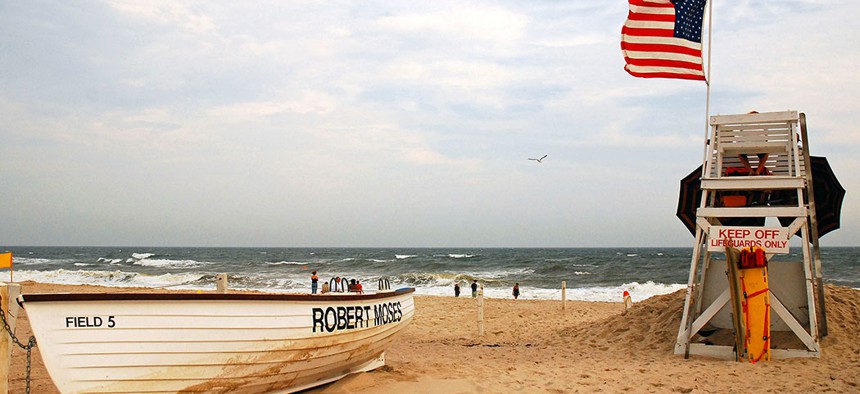Assemblyman Daniel O’Donnell recently introduced new legislation to rename Robert Moses State Park on Long Island. According to the bill memo, the hope is to create a commission that will choose a new name that “reflects the history of Long Island.” (O’Donnell represents the Upper West Side of Manhattan, but he grew up in Commack, a short drive north of the South Shore park.)
The temptation to remove the honor for a legendary mid-century master builder, whose legacy has been tarnished by revelations of racist views and exclusionary policies, is understandable.
But no one better reflects the history of the island – racist, segregated, car-dependent, but blessed with beautiful public beaches – than Robert Moses. For better and for worse, contemporary Long Island is Moses’ legacy.
As the bill memo notes, Moses destroyed the homes of tens of thousands of low-income New Yorkers in order to build highways to serve suburbanites. He even took active measures to prevent minorities from reaching the pristine beaches and parks he built on Long Island, such as making overpasses on the Southern State Parkway too low for buses from the city to reach Jones Beach. As the head of a series of quasi-governmental agencies, such as the Triborough Bridge Authority and the Long Island State Park Commission, Moses amassed and abused unprecedented power.
Yes, it makes sense that one would want to remove the name of a man who treated the public he ostensibly served with contempt. His disdain became readily apparent during his 1934 failed gubernatorial run, one of the biggest flops in New York’s history. (Full disclosure: this reporter is a lifelong Long Islander and is currently reading The Power Broker, Robert Caro’s epic biography of Moses, so she thinks about nothing but Robert Moses during her free time.)
But if you want a name for the park that reflects Long Island’s history, it’s hard to come up with a better one than Robert Moses. The man almost single handedly made the island what it is today through the system of parkways that he created. The parks and beaches he built continue to draw millions of people to them every year, and they remain feats of engineering brilliance. Fire Island, where Moses’ namesake park is located, was nothing more than a sand bar before New York’s prolific builder of public works saw the opportunity for something more.
And as for the racism, that is too is embedded in Long Island’s history, whether we like it or not. It’s built into the very foundation of its suburban neighborhoods, as minorities were steered into communities away from white families with brokers that outright refused to sell to non-white homeseekers. Levittown, the nation’s first true modern suburban neighborhood, was literally built for whites only before the Supreme Court ruled that its builders couldn’t be quite that explicit.
Long Island today remains incredibly segregated, with majority-white neighborhoods of great wealth located often just blocks away from lower-income, majority-minority neighborhoods. For this reason, Long Island’s public schools are also among the most segregated in the nation. And a recent investigation by Newsday found that discriminatory housing practices are still commonplace on the island.
In order to build his parks and parkways on Long Island, Moses made a number of backroom deals with both rich landowners and powerful political leaders. Corruption was rampant, with connected party bosses who could make things happen for the right price. Today, it’s hard to go more than a few weeks without reading a story about some public official on trial for corruption on Long Island – it’s another one of our traditions that the name Robert Moses reflects. And while the political machines may not be what they once were, bosses like Rich Schaffer in Suffolk County continue to flex their influence over what happens locally.
Moses was not exactly a good guy. That much is readily apparent to anyone who has even a cursory understanding of who he was and what he did. And generally, we can agree that naming parks after bad people is better avoided. Certainly, the commission proposed by O’Donnell’s legislation can find someone else who reflects the struggles of Long Islanders to make the region better and fix the wrongs of the past, celebrating their accomplishments by naming Robert Moses State Park after them instead. But that “beautiful state park,” as the bill memo calls it, would literally not have existed without Moses, nor would many of the other features that have come to define Long Island. And they might not have been built were Moses a better person.


